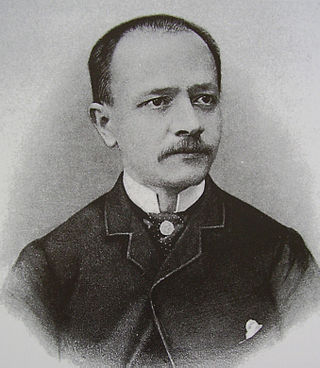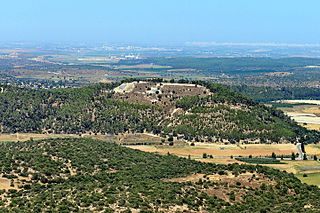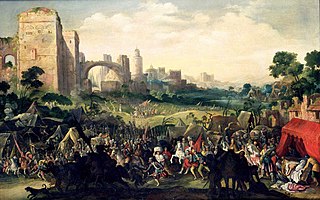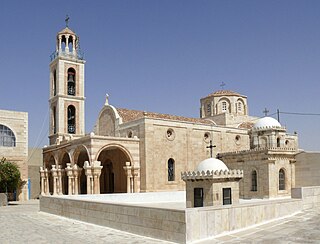Related Research Articles
Theodosius is a given name. It may take the form Teodósio, Teodosie, Teodosije etc. Theodosia is a feminine version of the name.

Auguste Molinier was a French historian.

Azekah was an ancient town in the Shfela guarding the upper reaches of the Valley of Elah, about 26 km (16 mi) northwest of Hebron.
Egeria, Etheria, or Aetheria was a Hispano-Roman Christian woman, widely regarded to be the author of a detailed account of a pilgrimage to the Holy Land about 381/2–384. The long letter, dubbed Peregrinatio or Itinerarium Egeriae, is addressed to a circle of women at home. Historical details it contains set the journey in the early 380s, making it the earliest of its kind. It survives in fragmentary form in a later copy—lacking a title, date and attribution.

Itinerarium Burdigalense, also known as Itinerarium Hierosolymitanum, is the oldest known Christian itinerarium. It was written by the "Pilgrim of Bordeaux", an anonymous pilgrim from the city of Burdigala in the Roman province of Gallia Aquitania.

Bethulia is a biblical "city whose deliverance by Judith, when besieged by Holofernes, forms the subject of the Book of Judith."
De locis sanctis was composed by the Irish monk Adomnán, a copy being presented to King Aldfrith of Northumbria in 698. It was based on an account by the Frankish monk Arculf of his travels to the Holy Land, from which Adomnán, with aid from some further sources, was able to produce a descriptive work in three books, dealing with Jerusalem, Bethlehem, and other places in Palestine, and briefly with Alexandria and Constantinople. It aimed to give a faithful account of what Arculf actually saw during his journey. Many of the manuscripts contain the second earliest known map of Jerusalem

The Monastery of St. Theodosius, also known as Deir Dosi and Deir Ibn Ubeid in Arabic, is a monastery founded around 476 by Saint Theodosius the Cenobiarch and that since at least the 12th century contains his tomb. It is located within the village of al-Ubeidiya, some 8 kilometres east of Bethlehem, on the road towards Mar Saba Monastery, in the West Bank, Palestine.
The Monastery of the Virgins is a structure uncovered during Benjamin Mazar's excavations south of Jerusalem's Temple Mount. The large number of Christian religious finds from the site have prompted its identification with a monastery described by a pilgrim, Theodosius the archdeacon, in his De Situ Terrae Sanctae, a work of the early 6th century. The building was constructed in the 4th century on the remains of an earlier Herodian building identified with the Second Temple courthouse, and was destroyed during the Persian sack of Jerusalem in 614.

Joseph's granaries is a designation for the Egyptian pyramids often used by early travelers to the region. The notion of a granary being associated with the Hebrew patriarch Joseph derives from the account in Genesis 41, where "he gathered up all the food of the seven years when there was plenty in the land of Egypt, and stored up food in the cities ... And Joseph stored up grain in great abundance, like the sand of the sea, until he ceased to measure it, for it could not be measured". "So when the famine had spread over all the land, Joseph opened all the storehouses and sold to the Egyptians". Similarly, in the Quran: "(Joseph) said: 'Give me charge of the granaries (خَزَائِنِ) of the land. I shall husband them wisely'" (12:55). The designation was used throughout the Middle Ages and only really abated in the Renaissance, when travel to the region became easier and closer investigation revealed the implausibility of the structures serving as storehouses for foodstuffs.

The Church of the Seat of Mary, Church of the Kathisma or Old Kathisma being the name mostly used in literature, was a 5th-century Byzantine church in the Holy Land, located between Jerusalem and Bethlehem, on what is today known as Hebron Road. It was built on the alleged resting place of Mary on the road to Bethlehem mentioned in the apocryphal Proto-Gospel of James. The church was built when Marian devotion first rose to great importance, following the First Council of Ephesus of 431. It is one of the earliest churches known to have been dedicated to the Theotokos in the entire Byzantine Empire.
Urbicius was imperial chamberlain, an office only held by eunuchs, to several Byzantine emperors of the 5th century. He lived to an advanced age, and held great political influence at the Byzantine court during the later 5th century.

The cartography of Jerusalem is the creation, editing, processing and printing of maps of Jerusalem from ancient times until the rise of modern surveying techniques. Most extant maps known to scholars from the pre-modern era were prepared by Christian mapmakers for a Christian European audience.
Bernard the Pilgrim, also called Bernard the Wise and Bernard the Monk, was a ninth-century Frankish monk. He is most recognisable for the composition of a travelogue, in which he details his journey around the Mediterranean, travelling through Italy, Egypt, the Holy Land, and France.

John of Würzburg was a German priest who made a pilgrimage to the Holy Land in the 1160s and wrote a book describing the Christian holy places, the Descriptio terrae sanctae.
The Libellus de locis sanctis is a 12th-century Latin guide book and travelogue of Palestine designed for the use of Christian pilgrims to the Holy Places. It "stands out" from the mass of medieval guide books "for its literary and informative qualities".

The Libellus de expugnatione Terrae Sanctae per Saladinum, also called the Chronicon terrae sanctae, is a short anonymous Latin account of the conquests of Saladin in the Holy Land between 1186 and 1191. The core of the text was written shortly after the events it describes and then supplemented by the addition of an account of the Third Crusade early in the thirteenth century. This probably took place at Coggeshall Abbey in England. Neither the original author nor the continuator/compiler is known by name.

The Liber Secretorum Fidelium Crucis is a Latin work by Marino Sanuto the Elder. It is one of the "recovery of the Holy Land" treatises intended to inspire a revival of the Crusades. It has also been named as Historia Hierosolymitana and Liber de expeditione Terrae Sanctae, and Opus Terrae Sanctae, the last being perhaps the proper title of the whole treatise as completed in three parts or "books".
Historical sources of the Crusades: pilgrimages and exploration include those authors whose work describes pilgrimages to the Holy Land and other explorations to the Middle East and Asia that are relevant to Crusader history. In his seminal article in the Catholic Encyclopedia, Dominican friar and historian Bede Jarrett (1881–1934) wrote on the subject of Pilgrimage and identified that the "Crusades also naturally arose out of the idea of pilgrimages." This was reinforced by the Reverend Florentine Stanislaus Bechtel in his article Itineraria in the same encyclopedia. Pilgrims, missionaries, and other travelers to the Holy Land have documented their experiences through accounts of travel and even guides of sites to visit. Many of these have been recognized by historians, for example, the travels of ibn Jubayr and Marco Polo. Some of the more important travel accounts are listed here. Many of these are also of relevance to the study of historical geography and some can be found in the publications of the Palestine Pilgrims' Text Society (PPTS) and Corpus Scriptorum Eccesiasticorum Latinorum (CSEL), particularly CSEL 39, Itinerarium Hierosolymitana. Much of this information is from the seminal work of 19th-century scholars including Edward Robinson, Titus Tobler and Reinhold Röhricht. Recently, the Independent Crusaders Project has been initiated by the Fordham University Center for Medieval Studies providing a database of Crusaders who traveled to the Holy Land independent of military expeditions.
References
- ↑ Tobias Nicklas in: C. R. Moss et al. (eds.), The Other Side: Apocryphal Perspectives on Ancient Christian “Orthodoxies” (2017), p. 26.
- Jenkins, Claude (1926), "Christian Pilgrimage, A. D. 500–800", Travel and Travellers in the Middle Ages, pp. 47–49
- Geyer, Paul (1898), Itinera Hierosolymitana, Vienna, republished in CCSL 175 (1965), 113-125 (addendum in CCSL 176, 852f.).
- Gildemeister, Johann (1882), Theodosius: De situ Terrae Sanctae im ächten Text und der Breviarius de Hierosolyma vervollständigt, Bonn.
- Pomialowsky, Johan (1891),Theodosius de situ terrae sanctae, Petersburg.
- Scarpanti, Edoardo (2007), "Problemi di filologia e di linguistica nei testi di pellegrinaggio tardolatini. Sull'autore del De situ Terrae Sanctae", Atti del Sodalizio Glottologico Milanese, vol. 2 n.s., pp. 181–194, doi:10.17605/OSF.IO/83VR6, ISSN 1972-9901
- Tobler, Titus (1865), Theodori liber de situ Terrae Sanctae, St. Gallen.
- Tobler, Titus & Antoine Molinier (1879), Itinera Hierosolymitana et descriptiones Terrae Sanctae, Geneva.
- Tsafrir, Yoram (1986). "The Maps Used by Theodosius: On the Pilgrim Maps of the Holy Land and Jerusalem in the Sixth Century C. E.". Dumbarton Oaks Papers. Dumbarton Oaks, Trustees for Harvard University. 40: 129–145.